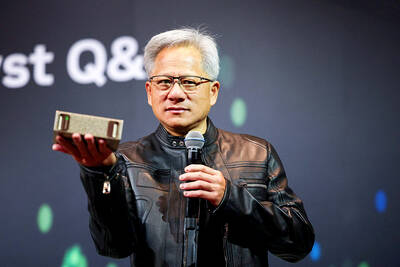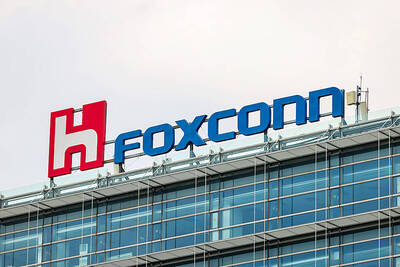Fuji Photo Film Co, the world's biggest maker of film used in flat panels, and SVA Electron Co (
Fuji Photo will own 25 percent of SVA-Fujifilm Opto- Electronic Materials Co, scheduled to start production in November next year, the Tokyo-based company said yesterday.
Shanghai-based SVA will hold a 75 percent stake in SVA-Fujifilm, which will make color filters used in laptops, monitors and large-screen TVs for the Chinese market, Fuji Photo said.
The venture marks the first time Fuji Photo will be making color filters for LCDs and comes as the company tries to raise sales of electronic parts to offset falling demand for traditional camera film. Shanghai-based SVA-Fujifilm will allow SVA to obtain color filters at a lower price than those the company currently imports from Japan, South Korea and Taiwan.
"Our partnership is sure to have bountiful returns," Gu Zhonghui (
SVA-Fujifilm has an output capacity of 70,000 filters a month and will employ about 500 workers when it starts "mass scale" production, Fuji Photo said in a statement.
The venture, with a paid-in capital of US$100 million, will make color filters using Fuji Photo's technologies, the statement said.
Gu said the filters will be sold to Shanghai SVA NEC Liquid Crystal Display Co, a venture of SVA Group and Japan's NEC Corp that makes LCDs. Color filters account for one-quarter of the cost of producing an LCD panel, he said.
Fuji Photo plans to invest ?4 billion (US$34 million) to set up a research and development unit in Shanghai to develop new products and LCD-related technologies, focusing on color filters.
"Fuji Film has positioned production of materials for LCDs and other flat-panel displays as a core business and will sustain its investment in R&D and enhanced production capacity," the company said.
The company targets US$26.9 billion in sales in the year ending March 31, 2010, from US$22.8 billion in the last fiscal year, said Noboru Sasaki, a Fuji Photo vice president, reiterating a forecast given in April.
Sales at its flat-panel material business, which includes color filters and film used in the displays, are projected to more than double by 2010 to US$2.7 billion, from US$1.2 billion in the year ending March 31, Sasaki said.
Domestic sales and exports of Chinese-made LCD TVs rose sixfold last year to 4.2 million units, from 700,000 a year earlier, the Beijing-based research company CCID Consulting Ltd (賽迪顧問) said.
BOE Technology Group Co (京東方科技集團), China's biggest maker of flat-panel displays, said in April it will spend 2.5 billion yuan to build a production line to make color filters in Beijing.

SEEKING CLARITY: Washington should not adopt measures that create uncertainties for ‘existing semiconductor investments,’ TSMC said referring to its US$165 billion in the US Taiwan Semiconductor Manufacturing Co (TSMC, 台積電) told the US that any future tariffs on Taiwanese semiconductors could reduce demand for chips and derail its pledge to increase its investment in Arizona. “New import restrictions could jeopardize current US leadership in the competitive technology industry and create uncertainties for many committed semiconductor capital projects in the US, including TSMC Arizona’s significant investment plan in Phoenix,” the chipmaker wrote in a letter to the US Department of Commerce. TSMC issued the warning in response to a solicitation for comments by the department on a possible tariff on semiconductor imports by US President Donald Trump’s

‘FAILED EXPORT CONTROLS’: Jensen Huang said that Washington should maximize the speed of AI diffusion, because not doing so would give competitors an advantage Nvidia Corp cofounder and chief executive officer Jensen Huang (黃仁勳) yesterday criticized the US government’s restrictions on exports of artificial intelligence (AI) chips to China, saying that the policy was a failure and would only spur China to accelerate AI development. The export controls gave China the spirit, motivation and government support to accelerate AI development, Huang told reporters at the Computex trade show in Taipei. The competition in China is already intense, given its strong software capabilities, extensive technology ecosystems and work efficiency, he said. “All in all, the export controls were a failure. The facts would suggest it,” he said. “The US

The government has launched a three-pronged strategy to attract local and international talent, aiming to position Taiwan as a new global hub following Nvidia Corp’s announcement that it has chosen Taipei as the site of its Taiwan headquarters. Nvidia cofounder and CEO Jensen Huang (黃仁勳) on Monday last week announced during his keynote speech at the Computex trade show in Taipei that the Nvidia Constellation, the company’s planned Taiwan headquarters, would be located in the Beitou-Shilin Technology Park (北投士林科技園區) in Taipei. Huang’s decision to establish a base in Taiwan is “primarily due to Taiwan’s talent pool and its strength in the semiconductor

French President Emmanuel Macron has expressed gratitude to Hon Hai Precision Industry Co (鴻海精密) for its plan to invest approximately 250 million euros (US$278 million) in a joint venture in France focused on the semiconductor and space industries. On his official X account on Tuesday, Macron thanked Hon Hai, also known globally as Foxconn Technology Group (富士康科技集團), for its investment projects announced at Choose France, a flagship economic summit held on Monday to attract foreign investment. In the post, Macron included a GIF displaying the national flag of the Republic of China (Taiwan), as he did for other foreign investors, including China-based